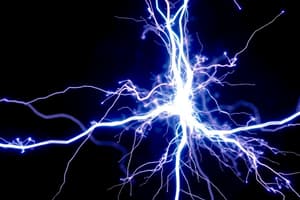Podcast
Questions and Answers
What is the primary force acting on a current-carrying wire when it's placed within a perpendicular magnetic field?
What is the primary force acting on a current-carrying wire when it's placed within a perpendicular magnetic field?
- Gravitational force
- Electrostatic force
- Magnetic force, also known as the catapult force or motor force (correct)
- Frictional force
In the experiment described, what change will reverse the direction of the force acting on the wire?
In the experiment described, what change will reverse the direction of the force acting on the wire?
- Both reversing the direction of the magnetic field or reversing the direction of the current (correct)
- Increasing the resistance in the circuit
- Reversing the direction of the current only
- Reversing the direction of the magnetic field only
What experimental setup is essential to demonstrating the effect of a magnetic field on a current-carrying wire?
What experimental setup is essential to demonstrating the effect of a magnetic field on a current-carrying wire?
- A circuit with only a switch and a constant current source.
- A circuit with a variable resistor and the wire placed perpendicular to a magnetic field. (correct)
- A circuit with a wire placed parallel to the magnetic field.
- A parallel circuit with a weak power supply.
What is critical regarding the relative orientation of the magnetic field and current for the force to act?
What is critical regarding the relative orientation of the magnetic field and current for the force to act?
In the experiment, why is a thick copper wire used instead of a thin one?
In the experiment, why is a thick copper wire used instead of a thin one?
What is the purpose of the conducting pivot in the described experimental setup?
What is the purpose of the conducting pivot in the described experimental setup?
What generalization can be derived based on the described experiment?
What generalization can be derived based on the described experiment?
According to the information provided, what practical application of the electromagnetic force is specifically mentioned?
According to the information provided, what practical application of the electromagnetic force is specifically mentioned?
Flashcards
Electromagnetic Force
Electromagnetic Force
The force experienced by a current-carrying wire when placed in a magnetic field.
Direction of Electromagnetic Force
Direction of Electromagnetic Force
The direction of the electromagnetic force on a current-carrying wire is perpendicular to both the magnetic field (B) and the current (I).
Electromagnet
Electromagnet
An electromagnet is a temporary magnet created by passing an electric current through a coil of wire.
Strength of Electromagnet
Strength of Electromagnet
Signup and view all the flashcards
Applications of Electromagnets
Applications of Electromagnets
Signup and view all the flashcards
Experiment on Magnetic Force
Experiment on Magnetic Force
Signup and view all the flashcards
Effect of Directions on Force
Effect of Directions on Force
Signup and view all the flashcards
Purpose of Experiment
Purpose of Experiment
Signup and view all the flashcards
Study Notes
Electromagnetic Force
- A current in a magnetic field experiences a force perpendicular to both the field and the current.
- This force is sometimes called the catapult force or motor force.
Effect of Relative Direction of B and I
- The magnitude and direction of the electromagnetic force depend on the relative directions of the magnetic field (B) and the current (I).
- This experiment demonstrates this relationship.
Experiment Setup
- A simple series circuit includes:
- A thermally-protected power supply
- A push-button switch
- A high-power rheostat
- A thick horizontal copper wire pivoted to resemble a garden swing
- A U-shaped magnet with a vertical magnetic field is placed perpendicular to the wire.
Experimental Procedure
- Step 1: Turn on the current using the push-button. Observe the wire's movement.
- Step 2 (Changing Current Direction): Reverse the connections to the battery terminals. Observe the wire's new movement.
- Step 3 (Changing Magnetic Field Direction): Exchange the poles of the U-shaped magnet (turning it upside down). Observe the wire's movement.
Purpose of Experiment
- The experiment assesses students' ability to design experiments, investigate problems, use apparatus, and draw conclusions based on results.
Studying That Suits You
Use AI to generate personalized quizzes and flashcards to suit your learning preferences.




